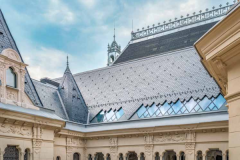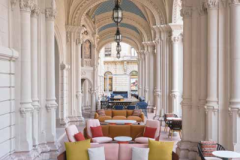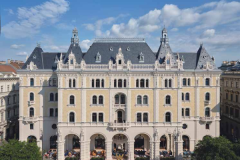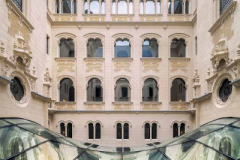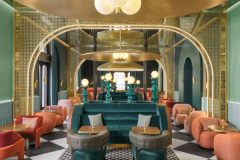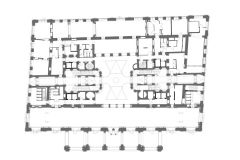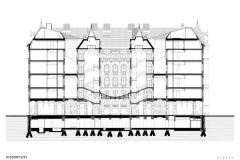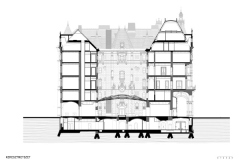The Luxurious New Aristocrat of Old Budapest
W Hotel (former Drechsler Palace), Budapest
Architect: Béla Bánáti
Text: György Szegő
Photos: Tamás Bujnovszky
The office of Ödön Lechner and Gyula Pártos in 1883, right after the design of the Szeged Town Hall, received a commission from the MÁV Pension Institute to design the apartment building opposite the Opera. The building was inspired by the Szeged Baroque there, and the castles seen on the French study tour here. The palace brought the Renaissance style features of French castles to Pest at the end of the 19th century. The Drechsler Palace, named after the coffee house, became an important stop for Lechner’s experimental spirit and search for style. The current renovation is also experimental. The covering of the old courtyard is brave attempt: the architectural design of the glass roof of the inner courtyard that accommodates the lobby brought a series of innovative professional challenges. The glass roof is a breathtakingly light form. Thanks to complex, precise planning, they found the location of the structure and finally its parametric form. The meeting of conservation and contemporary architecture is embodied in solutions that meet the expectations of the W hotel chain. The reception area and terrace open towards the Opera, and the units providing hotel functions can be approached from the central inner courtyard. On the ground floor, the reception functions: the lobby, catering and social spaces, on the basement floor there are rest, regeneration and service spaces. The interior design is dominated by the character of the W hotels, but the lace-like metal arches in the basement, the bar and the entrance corridor allow us to see the original architecture as well, hinting at the history of the house and the city.
Client: QPR Properties
Project management: Habitat Management
General plans: Bánáti + Hartvig Architects
Leading architect: Béla Bánáti
Project architects: Szabolcs Lénárt, Judit Zajacz
Architects: Bodó Bánáti, András Csiha, Gergő Kádár, Lilla Pusztai, Ákos Szécsi, Norbert Szilágyi, Gergő Szloboda
Art historians: András Hadik, Zoltán Fehérvári
Restoration: Gergely Kelecsényi, Áron Sándor – Alakart
Reconstraction: Kornél Baliga – Korinterni
Interior design: Ian Bayuss, Stephane Reanud – Bowler James Brindley Studio
Ornamental tin roof construction plan: Péter Birghoffer
Structure: Balázs Takács, Tamás Szutor – Frt Raszter
Framework: Csaba Kovács, Bálint Trombitás – Reticolo
Glass construction: György Stocker, Botond Madaras – Stokplan
Fire protection: Lajos Takács, Attila Zsitva – Takács-Tetra
Current power: Zoltán Ivanics, Attila Nagy – Provill
Weak power: Olivér Nagy – Complex It
Mediom power: Gábor Pendu, Ferenc Gulyás – GIF
HVAC: László Temesvári, József Nagy, Ákos Tóth – Temesvári Tervező
Sprinkler: András Hajdú, Veronika Temesvári, Levente Soós – Dunamenti Tűzőr
Pool technology: Zoltán Sallai – S-Terv
Automatic systems: Péter Nagy – Welltech
Facade lights: János Perness – Rió Lámpastúdió; János Farkas – Design and Light
Environment: Lajos Koszorú, Bálint Koszorú, Péter Marosi – Város-Teampannon
Traffic: Éva Kovács, Roland Beller – Főmterv
Acoustics: Róbert Csott – ’95 Apszis
Elevator: Zsolt Makovszky – Mamég
Environment protection: Gábor Péter – Belemnites
Realization plan, project control: Ida Kiss, Marcell Lukátsi, Kroki Stúdió, Balázs Kéry, Edina Király – DVM Group
Kitchen and hotel texhnology: Frank Wagner, Christoph Hagen – K’drei
Interior lights: Ana Ayala – Artec3
Furtinure realization: Mobil Project
Environment realization: Swietelsky Magyarország

